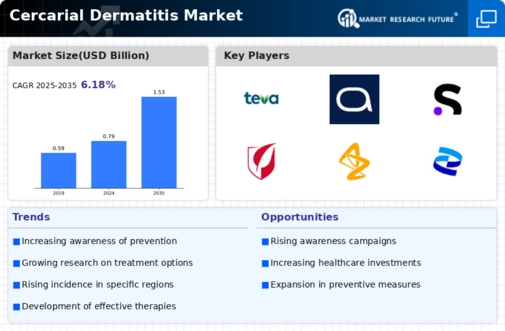Emerging Treatment Options
The emergence of new treatment options for cercarial dermatitis is a promising driver for the Cercarial Dermatitis Market. Recent advancements in pharmacotherapy and topical treatments have shown potential in alleviating symptoms and improving patient outcomes. As healthcare providers become more aware of these options, the adoption of new therapies is likely to increase. This trend may also encourage pharmaceutical companies to invest in the development of novel treatments, thereby expanding the market. Furthermore, the availability of diverse treatment modalities can cater to varying patient needs, enhancing overall satisfaction and compliance with treatment regimens.
Increased Public Health Initiatives
Public health initiatives aimed at educating communities about cercarial dermatitis are becoming more prevalent, serving as a significant driver for the Cercarial Dermatitis Market. These initiatives often focus on prevention strategies, such as promoting safe recreational practices in freshwater environments. By raising awareness about the risks associated with cercarial dermatitis, public health campaigns can potentially reduce the incidence of the condition. This increased awareness may lead to a higher demand for preventive products and treatments, thereby stimulating market growth. Additionally, collaboration between health organizations and local communities can enhance the effectiveness of these initiatives, further solidifying the market's expansion.
Rising Incidence of Cercarial Dermatitis
The increasing incidence of cercarial dermatitis is a notable driver for the Cercarial Dermatitis Market. Reports indicate that the prevalence of this condition has been on the rise, particularly in regions with abundant freshwater bodies. This uptick in cases is likely attributed to environmental changes and increased human interaction with water sources. As more individuals experience symptoms, awareness and demand for effective treatments are expected to grow. Consequently, healthcare providers and pharmaceutical companies may focus on developing targeted therapies, thereby expanding the market. The rising incidence not only highlights the need for effective management strategies but also emphasizes the importance of public health education regarding prevention and treatment options.
Impact of Climate Change on Disease Patterns
Climate change is influencing disease patterns, including the incidence of cercarial dermatitis, which serves as a significant driver for the Cercarial Dermatitis Market. Alterations in temperature and precipitation patterns can affect the habitats of freshwater snails, the intermediate hosts of the parasites responsible for cercarial dermatitis. As these environmental changes occur, the risk of exposure to infected waters may increase, leading to a higher incidence of the condition. This evolving landscape necessitates adaptive strategies in public health and treatment approaches, potentially driving market growth as stakeholders respond to the changing dynamics of cercarial dermatitis.
Growing Investment in Research and Development
Investment in research and development (R&D) is a critical driver for the Cercarial Dermatitis Market. Pharmaceutical companies and research institutions are increasingly allocating resources to understand the pathology of cercarial dermatitis and to develop innovative treatment modalities. This focus on R&D is likely to yield new therapeutic agents and preventive measures, enhancing the overall treatment landscape. Furthermore, government funding for public health research may bolster these efforts, leading to a more robust pipeline of products aimed at managing this condition. As new treatments emerge, the market is expected to expand, catering to the needs of affected populations and healthcare providers.


















Leave a Comment